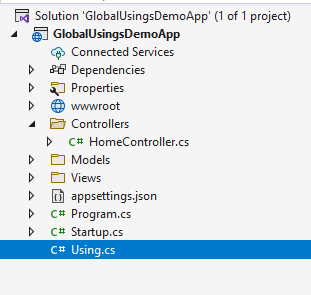
Every C# class file begins with a list of using statements that are necessary for implementation. Much of this code is repetitive and takes up more bytes in files.
If we create an ASP NET Core Web Application(MVC) with Visual Studio 2022 preview or higher with .NET 6 SDK we will be getting the below code in HomeController.cs
1
2
3
4
5
6
7
8
9
10
11
12
13
14
15
16
17
18
19
20
21
22
23
24
25
26
27
28
29
30
31
32
33
34
35
36
37
using GlobalUsingsDemoApp.Models;
using Microsoft.AspNetCore.Mvc;
using Microsoft.Extensions.Logging;
using System;
using System.Collections.Generic;
using System.Diagnostics;
using System.Linq;
using System.Threading.Tasks;
namespace GlobalUsingsDemoApp.Controllers
{
public class HomeController : Controller
{
private readonly ILogger<HomeController> _logger;
public HomeController(ILogger<HomeController> logger)
{
_logger = logger;
}
public IActionResult Index()
{
return View();
}
public IActionResult Privacy()
{
return View();
}
[ResponseCache(Duration = 0, Location = ResponseCacheLocation.None, NoStore = true)]
public IActionResult Error()
{
return View(new ErrorViewModel { RequestId = Activity.Current?.Id ?? HttpContext.TraceIdentifier });
}
}
}
As you can see from above that most of these namespaces imported here are likely to be required in other .cs files as well. The developer will end up writing multiple imports of the same namespace in multiple .cs files. To Avoid this with C# 10.0 Microsoft introduced the concept of declaring and importing namespaces globally.
Adding Global ‘Using.cs’ file to a project in .NET 6
Add a new file called Using.cs (can be added to the project root level. The name of the file can be anything) and start importing most likely used namespaces in this file by prefixing with global keyword.
The content of Using.cs will be:
1
2
3
4
5
6
7
8
global using GlobalUsingsDemoApp.Models;
global using Microsoft.AspNetCore.Mvc;
global using Microsoft.Extensions.Logging;
global using System;
global using System.Collections.Generic;
global using System.Diagnostics;
global using System.Linq;
global using System.Threading.Tasks;
That’s it! Now your HomeController.cs can be simplified and it can start referring classes defined namespaces present in Using.cs
1
2
3
4
5
6
7
8
9
10
11
12
13
14
15
16
17
18
19
20
21
22
23
24
25
26
27
28
namespace GlobalUsingsDemoApp.Controllers
{
public class HomeController : Controller
{
private readonly ILogger<HomeController> _logger;
public HomeController(ILogger<HomeController> logger)
{
_logger = logger;
}
public IActionResult Index()
{
return View();
}
public IActionResult Privacy()
{
return View();
}
[ResponseCache(Duration = 0, Location = ResponseCacheLocation.None, NoStore = true)]
public IActionResult Error()
{
return View(new ErrorViewModel { RequestId = Activity.Current?.Id ?? HttpContext.TraceIdentifier });
}
}
}
Combining Top-level statements(.NET 5) with global using in C#
Top-level statements enable developers to avoid the extra ceremony required by placing the program’s entry point in a static method in a class. The typical starting point for a new console application looks like the following code:
1
2
3
4
5
6
7
8
9
10
11
12
using System;
namespace Application
{
class Program
{
static void Main(string[] args)
{
Console.WriteLine("Hello World!");
}
}
}
Above 11 lines contain only one line of executable code Console.WriteLine("Hello World!");. You can simplify that program with the new top-level statements feature. That enables to remove all but two of the lines in this program:
1
2
using System;
Console.WriteLine(args);
We need not declare args variable. For the single source file that contains your top-level statements, the compiler recognizes args to mean the command-line arguments. The type of args is a string[], as in all C# programs.
With global using C# 10.0 feature, the console app code can be reduced to 1 line!
1
Console.WriteLine(args);
When should you not move an import statement to global using?
Moving functionality specific namepsaces to global using is not recommended always. At times it may reduce the readibilty for a new developer looking at the code. For example moving Microsoft.AspNetCore.SignalR to global using may not provide an idea to developer that the functionality deals with SignalR.
1
2
3
4
5
6
7
8
9
10
11
12
13
14
using System;
using System.Threading.Tasks;
using Microsoft.AspNetCore.SignalR;
public class ViewHub : Hub
{
public static int ViewCount {get;set;} = 0;
public async Task NotifyWatching(){
ViewCount++;
await this.Clients.All.SendAsync("viewCountUpdate", ViewCount);
}
}
Hence the ideal approach would be to move System and System.Threading.Tasks to Using.cs and retain Microsoft.AspNetCore.SignalR in same file:
1
2
3
4
5
6
7
8
9
10
11
12
using Microsoft.AspNetCore.SignalR;
public class ViewHub : Hub
{
public static int ViewCount {get;set;} = 0;
public async Task NotifyWatching(){
ViewCount++;
await this.Clients.All.SendAsync("viewCountUpdate", ViewCount);
}
}
Conclusion
With global using C# 10.0 feature Microsoft has reduced overhead of importing namepsaces and when combined with other .NET features such as Top-level statements, they simplify a lot of things for developers.
